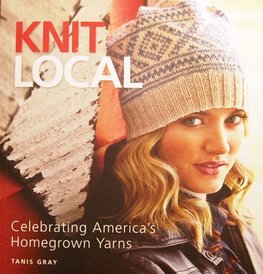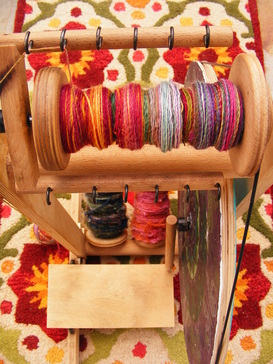
Insert wonderful intro paragraph… Okay I can’t think of one. Let’s start it like this: I love this book and I hope to be like many of these companies one day. It is inspirational to me not just for the great knitting patterns but also to realize that yes, there are huge yarn companies like Lion Brand and Bernat (and nothing against them, their yarn choices over the years have gone from plain acrylics to some wonderful textures and blends), but small is possible. And small is beautiful and can be very successful.
The book showcases 28 companies across the United States that make yarn- some hand dye, some are the farms growing the fiber, many have mini-mills they work with, and some are the mills themselves. The book is arranged by region (Northeast, South, Midwest, West) and highlights a few individual sellers from each region. The biggest sections are the Northeast and the West, which, knowing the history of the American textile industry, make perfect sense. The Northeast was home to the US textile industry during the Industrial Revolution, and the West has lots of acreage with lots of sheep (although I’m pretty sure cattle outnumber sheep in Wyoming). At the end of each region's section is also a list of other sellers.
The book showcases 28 companies across the United States that make yarn- some hand dye, some are the farms growing the fiber, many have mini-mills they work with, and some are the mills themselves. The book is arranged by region (Northeast, South, Midwest, West) and highlights a few individual sellers from each region. The biggest sections are the Northeast and the West, which, knowing the history of the American textile industry, make perfect sense. The Northeast was home to the US textile industry during the Industrial Revolution, and the West has lots of acreage with lots of sheep (although I’m pretty sure cattle outnumber sheep in Wyoming). At the end of each region's section is also a list of other sellers.

The individual sellers provide a story of their who-what-when-where –why and there is a knitting pattern featuring the company’s yarn after each story. Each story also has pictures of the proprietors at work- working with their flocks, their tools of the trade, and finished yarns. I love the picture of handdyed yarns strung between trees from Farmhouse Yarns in page 19. Remember above when I said it was also inspirational to me- that’s one of those pics and is the one on page 129 of handdyed yarns on laundry drying racks at Red Barn Yarn. There’s a picture of Pagewood Farm’s outdoor dye area on page 151- I would love to have that someday.
If you’re getting the book for the knitting patterns there are a 28 to choose from- small projects like mittens and hats, to large projects like car coats and shawls. My favorite patterns are the Cabled Car Coat on page 20, the Oquirrh Mountain Wrap on page 160, and Evergreen Ankle Socks on page 136. I like knitting socks (portable project), long length sweaters, and shawls, so it’s no doubt those three made the top want-to-knit. I think all the patterns are beautiful, but I will focus on those three possibilities right now (along with about 10 other knitting projects.)
If you’re getting the book for the knitting patterns there are a 28 to choose from- small projects like mittens and hats, to large projects like car coats and shawls. My favorite patterns are the Cabled Car Coat on page 20, the Oquirrh Mountain Wrap on page 160, and Evergreen Ankle Socks on page 136. I like knitting socks (portable project), long length sweaters, and shawls, so it’s no doubt those three made the top want-to-knit. I think all the patterns are beautiful, but I will focus on those three possibilities right now (along with about 10 other knitting projects.)
My only qualm with the book is this book is titled “Knit Local” which #1- kind of sounds like the book should be about local yarn shops, not US yarn companies. And #2- semantics aside, some of the companies have limited yarn lines made in the USA. Some like Brown Sheep Company in Nebraska, Green Mountain Spinnery in Vermont, and the companies that are on farms are 100% American. A few companies have several yarn lines, but only one made in the USA. I would have liked it to be a 100% yarns made in America book. It’s not like the author didn’t have many other choices- remember the lists of other businesses at the end of each region.
Still, hearing the stories of the farms and small cottage industries created by fiber-loving folks gives me a pick me up when I need it. Being a yarnie full time is possible with some skill, time, and gumption. I have the people in this book to prove it.
Still, hearing the stories of the farms and small cottage industries created by fiber-loving folks gives me a pick me up when I need it. Being a yarnie full time is possible with some skill, time, and gumption. I have the people in this book to prove it.




 RSS Feed
RSS Feed
